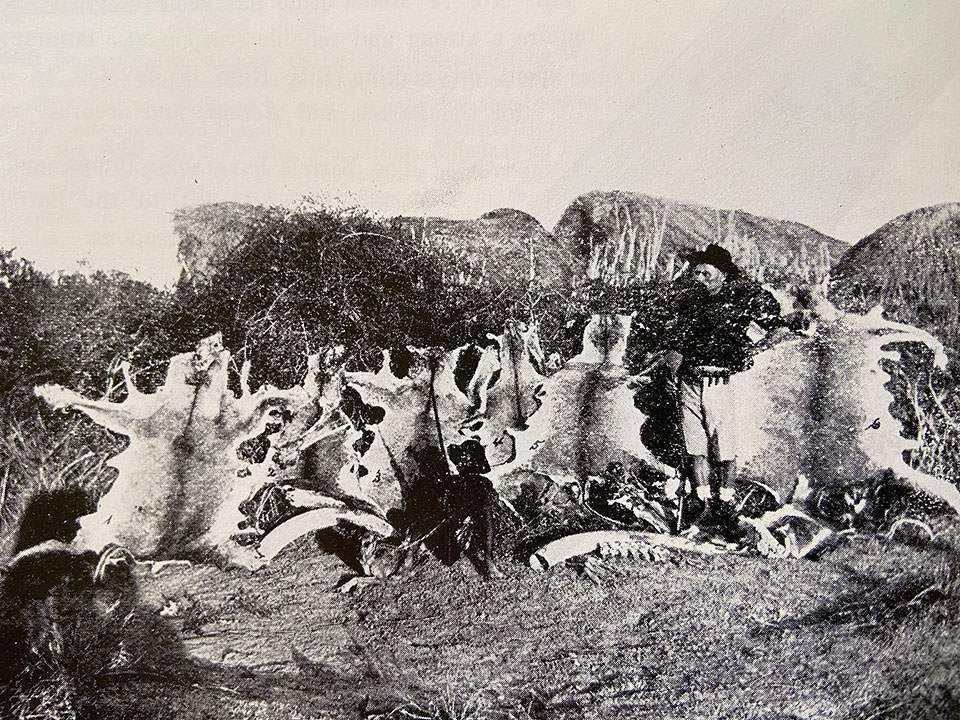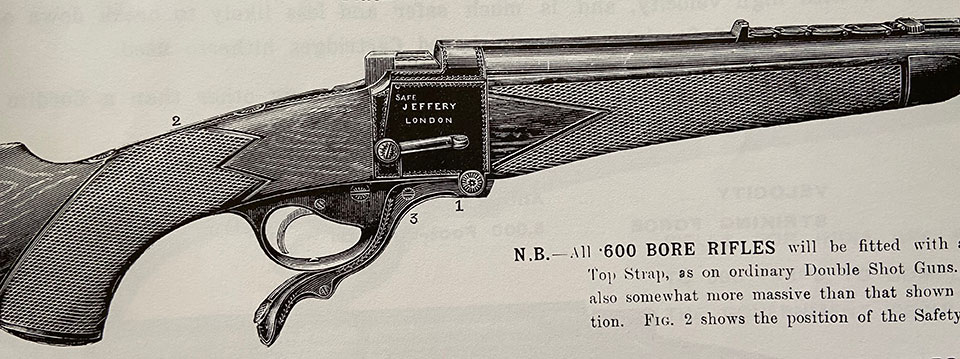Recently we examined the .600 Nitro Express and, while concentrating on a modern version, built by Westley Richards, I noted the development of the cartridge by another firm; W.J Jeffery.
I have a 1912 catalogue from Jeffery and today it makes interesting reading, not just for the historically accurate technical data it provides but also for the very different world it reflects in its prose.

Before the First World War, Africa was viewed as a land of endless vastness, still many of its deepest recesses lay largely unexplored in any meaningful way and its natural habitat and fauna was considered a wasteland that needed taming in order to turn it into a model of European farming.
The vision for ‘civilising’ Africa was seen by many administrations as a process of removing the wild dangers it contained and creating a pastoral, managed landscape that would sustain the population and lend itself to order and efficient administration. The native animals, especially the dangerous ones, were considered to be a nuisance. The numbers of animals Africa-based hunters in the early twentieth century bagged is incredible by today’s standards. One testimonial for the .600NE comes from a big game hunter called Mr. C. Larsen, who is quoted saying: “ I have to date shot fifty two elephants, six rhinos and many other animals that are too numerous to mention, With the .600 rifle I lost only one bull out of thirty six that I killed “.
I have to date shot fifty two elephants, six rhinos and many other animals that are too numerous to mention.
The catalogue illustrates Jeffery’s version of the .600 NE. It is a boxlock with snap under-lever. Jeffery explains; ‘We recommend the under lever push-forward snap action for all powerful smokeless powder rifles. It s far stronger than the top lever and it admits of nearly ten times as much pressure being applied to with draw the bolt, as can be got from a top-lever.’
This is an interesting and accurate observation, and not one that is often discussed these days. The direct action of the under-lever on the Purdey Bolt is certainly more efficient than operating it through the multitude of linked appendages necessary when transferring the movement of a top-lever, through a Scott spindle to the sliding bolt located in the bar.
The other claim of the increased strength of the action gained by the omission of the vertical hole drilled into the action, directly behind the breech-face to carry the Scott Spindle, is also correct. With an under-lever action, the rifle retains a solid action from breech face back.
A safety feature the catalogue entry recommends is a non-automatic safety. ‘When a sportsman is hurried, it is very likely that he will put the rifle to his shoulder without thinking about pushing forward the safety slide’.
The rifle illustrated is a; ‘best quality under-lever, snap-action, double bolted with strong doll’s head extension, 24” Krupp steel barrels, sighted to 200 yards. Deadened top rib, pistol grip stock, lever forepart fastener. engraved and finished to the very best style and fitted with powerful ejecting action.’
The price of Jeffery’s .600NE is £65. For comparison, their best quality ‘London Pattern’ side-lock cost £55 and their plain ‘shot & ball’ hammer gun was just £15.
The price of Jeffery’s .600NE is £65. For comparison, their best quality ‘London Pattern’ side-lock cost £55 and their plain ‘shot & ball’ hammer gun was just £15. Jeffery’s most expensive Anson & Deeley action shotgun was £20. So, the big .600 was an expensive purchase in its day. The typical working class family budget at the time was 22 shillings and sixpence per week. The £65 price tag would have covered two first class tickets on the maiden voyage of the Titanic, which sailed in the same year the catalogue was produced.
Jeffery compares the power of the .600NE to the 4-bore black powder rifles of the previous era. ‘The striking force of the Jeffery.600 bullet is 8,700 lbs, whereas a 4-bore bullet driven by 14 drams of black powder only gives 7,000 lbs’.
Two bullet types were offered: a No.1 pattern soft-nose expanding bullet and a No.2 pattern nickel-covered solid bullet. Bullet weight is 900 grains and the cordite charge is 100 grains. Cartridges cost 47 shillings and sixpence per hundred, which is a hefty sum, when compared to the cost of, for example, sporting .303 cartridges, which were seventeen shillings and sixpence per hundred.
Now, back to the exciting event used in the catalogue to promote the .600 as an unbeatable dangerous game getter. Mr Charles (Karl) Larsen, a Danish professional hunter, operating in Portuguese East Africa. While on the trail of a wounded bull elephant in January 1909, he encountered lion spoor.
Th story continues; ’calling up his gun bearer and dog and taking up good position, Larsen imitated the roar of a lion. Almost immediately a fine young lion bounded out of a thicket only to receive a bullet in the heart. A companion which followed a second or two later shared the same fate and almost before the hunter had time to re-load, two others appeared, followed shortly after by three more. With remarkable coolness, Larsen stood his ground and, firing and reloading with great rapidity, succeeded in bringing down all seven lions. His weapon was a double barrelled elephant rifle by W. J. Jeffery of .600 calibre and the bullets were dum-dums’. Seven lions in two minutes today seems unthinkable. There are very few hunters alive today who have shot seven lions in their lifetime.

As the First World War loomed, the Jeffery .600 stood proud as the most fearsome hunting rifle available. As a double it was unsurpassed but those wanting a less expensive version could opt for the falling-block single barrel .600, at a relatively modest cost of £20, or £30 in best quality.
In response to the publication of this article, the current owner of one of Karl Larssen's .600NE Jeffery rifles contacted us with the following information:
'Covid-19 obliged us all to work from home, and it allowed me time to take out of the vault some special guns and showcase them (dream about the past) on my desk. Karl Larsen's first .600 NE was an exemple. Built in 1902, he acquired it around 1904 not from Jeffery as not recorded in the ledgers, and it is the only one to date to surface with the full 120 grains cordite proof as pictured in the Jeffery catalogue and your website, where he is holding it in his right hand, with the little black boy of his native mistress barely visible in the middle of the picture of his seven 7 lions in a few minutes with a .600 Jeffery.
...it is the only one to date to surface with the full 120 grains cordite proof as pictured in the Jeffery catalogue...
Larsen sold that 120 grain proof .600NE Jeffery to Hans Schomburgk around September 1907, according to an original 1910 book by Hans Schomburgk, the second owner and user of this .600 Jeffery. This 1902 Jeffery is the 6th .600 double rifle produced and also the heaviest, from about 1904 to 1920, she was used by at least 3 famous professional elephant hunters in Africa, Karl Larsen, Hans Schomburgk and Lammond Hemming.
At some point in time the big Jeffery found its way back to the W.J. Jeffery shop in London and must have remained in inventory for some time. The French Senator Henry Chamault finally bought her and took her back to his plantations in Cameroun. Chamault is the first recorded name in the Jeffery ledgers, however without date. The American real estate tycoon F.P Williamson is the last recorded owner, his purchase in the Jeffery ledgers dated 1952. F.P.W used it on elephants, rhinos, buffalos and lions on several Kenyan safaris guided by Kerr & Downey, as described in an American Rifleman magazine article, it remained in his possession for nearly 60 years.
I acquired that Jeffery in 2011 and she returned the same year to the Tanzanian Okavango Delta. After 118 years of obvious use but good care and service, at least two trips over the oceans back to London, which meant several weeks aboard steam ships - and several years in the African bush, she is still in perfect working condition.'

Published by Vintage Guns Ltd on (modified )




